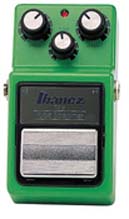I had recently picked up a chorus unit as I was interested in adding some thickened multi-guitar sounds to my rig. It had been years since I had played with chorus units, seeing as I had largely overdone the effect in the ‘80s as many other players did. I thought however that now would be a good time since I have more taste now to be able to use the effect more sparingly.
Read More »
Category Archives: Effects
Keeley Electronics DS-1 Seeing Eye Mod
Robert Keeley’s name has grown substantially over the past couple of years and with good reason: he’s an electrical engineer by trade blessed with a musician’s ear for good tone. That combination has proved to be a blessing for his business, Keeley Electronics, and has earned Robert the reputation of knowing what sounds good and being able to build those tones into his final products for his customers.
Read More »
Fulltone Fulldrive 2 Review
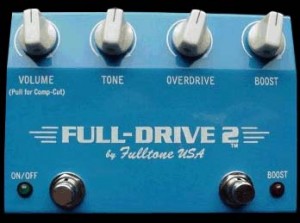 Overdrive and distortion pedals, particularly vintage models from companies such as Ibanez (check out TS-808 tube screamer prices on Ebay), Boss (OD-1 very collectable), MXR, etc., have been very popular lately. One reason is of course primarily the tone that they offer. The other, is that plain and simply, they’re just built better than what you can commercially get today. I recently opened up an old MXR distortion plus and was impressed that it had not one, but four signed signatures on it, for testing and “signing off” on the unit during various stages of construction. You don’t often see that kind of care being taken when building pedals anymore. These days, it is about getting the bottom line (i.e. the cost) down to as little as possible. Even companies such as Boss that mass-produced many units since the ‘70s, did an excellent job and the quality was top notch while the pedals were being produced in Japan. Now, is well, another story.
Overdrive and distortion pedals, particularly vintage models from companies such as Ibanez (check out TS-808 tube screamer prices on Ebay), Boss (OD-1 very collectable), MXR, etc., have been very popular lately. One reason is of course primarily the tone that they offer. The other, is that plain and simply, they’re just built better than what you can commercially get today. I recently opened up an old MXR distortion plus and was impressed that it had not one, but four signed signatures on it, for testing and “signing off” on the unit during various stages of construction. You don’t often see that kind of care being taken when building pedals anymore. These days, it is about getting the bottom line (i.e. the cost) down to as little as possible. Even companies such as Boss that mass-produced many units since the ‘70s, did an excellent job and the quality was top notch while the pedals were being produced in Japan. Now, is well, another story.
Read More »
Line6 PODxt
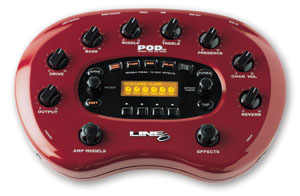 Line6’s original POD unit has been wildly successful since its inception just a few short years ago and with good reason. Any guitarist can imagine the appeal of having a musical tool that can call up a variety of guitar tones instantly at the push of a few buttons and a twist of a few knobs. In fact, having this versatility in a small package made the original POD a mainstay for studio musicians and recording studios.
Line6’s original POD unit has been wildly successful since its inception just a few short years ago and with good reason. Any guitarist can imagine the appeal of having a musical tool that can call up a variety of guitar tones instantly at the push of a few buttons and a twist of a few knobs. In fact, having this versatility in a small package made the original POD a mainstay for studio musicians and recording studios.
While a new loyal group of Line6 users embraced this digital modeling technology used in the original POD, some musicians were quick to judge negatively against the POD and modeling technology in general – even if they never had tried it in the first place! It is interesting that while we as musicians like to think of ourselves as individuals, we can also sometimes be "set in our ways" (how many of us play Strats, Pauls, and PRS’ or Marshall and Mesa Boogie amps in part because so-and-so does?) – and no debate has been stirred up with so much passion over recent years than the topic of "modeling vs. the real thing." It’s easy to see modeling-critics ripping apart these solutions, not only because they promise a plethora of the greatest tones according to how they are marketed, but also because they are simply new and perhaps threaten the status quo of how music is to be made and heard.
Read More »
Frantone The Sweet Fuzz Pedal
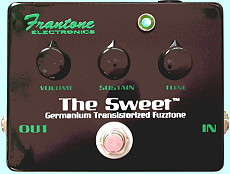 It has been my discovery that Fuzz boxes are an interesting breed of effect pedal. At times, they can be the right tool for the right job, and at other times they can lay dormant in your chain of signal flow.
It has been my discovery that Fuzz boxes are an interesting breed of effect pedal. At times, they can be the right tool for the right job, and at other times they can lay dormant in your chain of signal flow.
However, the fuzz box has found its way in many recordings, and has been used by many artists. Before trying this unit out, I had very little prior knowledge of fuzz boxes and what to expect.
Read More »
Hughes and Kettner Tube Factor Overdrive/Distortion Pedal
Overdrive pedals that incorporate tubes have been around for many years. As the designs themselves have progressed, the sound of these devices have also improved significantly. For example, initially tube overdrive pedals ran the preamp tube or tubes with very low voltages and this changed the sonic characteristics of the effect. Many of today’s units however now run the tubes at the high plate voltages (in the neighborhood of 300 volts!) that the tubes were intended to be operated at.
In the months ahead, we hope to bring you a roundup of many different models of tube overdrive pedals. For now, we’ve taken a look at an especially impressive model: Hughes and Kettner’s Tube Factor.
Read More »
Line6 GuitarPort
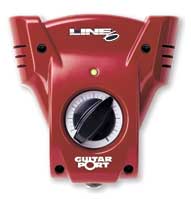 The first time I saw the Line6 GuitarPort, I was confused by what it was, as well as skeptical about what it could actually do based on its simple appearance. My curiosity however, got the better of me, so I decided to take an in depth look at it, specifically, its functionality and features pertaining to my computer-based recording setup.
The first time I saw the Line6 GuitarPort, I was confused by what it was, as well as skeptical about what it could actually do based on its simple appearance. My curiosity however, got the better of me, so I decided to take an in depth look at it, specifically, its functionality and features pertaining to my computer-based recording setup.
To tell you the truth, I wasn’t really expecting much given the low MSRP of $229.99 US after all, I have played through many of today’s new amp and effect modelers, and have learned that you generally get what you pay for. In any case, I was quite surprised at what I found out about the unit. First, it isn’t merely a guitar modeler and recording interface; it is a totally intuitive, interactive guitar processing, practice and teaching system for guitarists of any skill level.
Read More »
Ibanez TS-9 Tube Screamer Reissue Review
Ibanez began producing pedal effects in the mid 70’s. At that time, many of their products were remarkably similar in sound to one of the leading effects maker of that era, MXR. In the early 80’s, the first Tube Screamer, model TS-808, was introduced and became a success. In 1982, the updated Tube Screamer, model TS-9, was introduced and was even more successful. Acclaimed for its soft-clipping distortion characteristics that was fairly touch-responsive, especially for a pedal made in that time, the Tube Screamer became a favorite for both blues guitarists as well as rock guitarists that wanted to add more punch to their already distorted sound.
With prices of original TS-808 and TS-9 Tube Screamers literally going for hundreds of dollars more than they ever sold for new (As of this writing, TS-808’s have gone for $450+ on Ebay and I’ve seen original TS-9s in the $250-$300 price range), Ibanez decided to make the most of this demand and reissue the Tube Screamer TS-9.
Read More »
Bixonic Expandora EXP-2000R Distortion Review
The Bixonic Expandora EXP 2000R is a unique looking pedal, with a novel approach and style that sets it apart from today’s invasion of new overdrive units. A reissue of the original Expandora 2000, the new unit incorporates some new sounds and design updates from the original. Within the confines of its sturdy housing, it contains a broad palette of sounds for the player looking to sample some different flavors of overdrive without having to commit to the cost or space of several individual pedals.
Read More »
Electro-Harmonix Micro Synthesizer
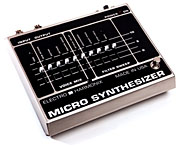 Electro-Harmonix was founded in the late ’60s with the mission to produce unique and affordable effects for all musicians. Through the ’70s, Electro-Harmonix produced a number of top-sellers such as the Electric Mistress flanger, Small Stone phaseshifter, and Big Muff distortion. While the company eventually folded by the early ’80s, Electro-Harmonix is now back, offering reissues of their classic designs as well as new updated effects. Additionally, Electro-Harmonix (a division of New Sensor) now also produces a line of vacuum tubes, designed to sound like the classic tubes made from the best companies of the past, including Mullard and Telefunken.
Electro-Harmonix was founded in the late ’60s with the mission to produce unique and affordable effects for all musicians. Through the ’70s, Electro-Harmonix produced a number of top-sellers such as the Electric Mistress flanger, Small Stone phaseshifter, and Big Muff distortion. While the company eventually folded by the early ’80s, Electro-Harmonix is now back, offering reissues of their classic designs as well as new updated effects. Additionally, Electro-Harmonix (a division of New Sensor) now also produces a line of vacuum tubes, designed to sound like the classic tubes made from the best companies of the past, including Mullard and Telefunken.
Certainly one of the most unusual devices made for guitarists is the Electro-Harmonix Micro Synthesizer. An all-analog design, the Micro Synthesizer boasts the ability to provide the great older analog synthesizer sounds made famous by Moog, Avitar, Art and by using a guitar instead of a keyboard as the input device. Listen to Pink Floyd from the "Dark Side of the Moon" era or recall the theme music from Doctor Who and you’ll get the idea of the analog synthesizer sound. For many of us that were too young to experience the analog synthesizer’s heyday (I was only a year old when "Dark Side of the Moon" was released back in 1973), what a trip the Micro Synthesizer offers with sounds that can be explored for a new generation of players. It’s no wonder that newer bands such as Smashing Pumkins, Beck, and Moby have incorporated the Micro Synthesizer into their own palette of creative sonic tools.
Read More »
